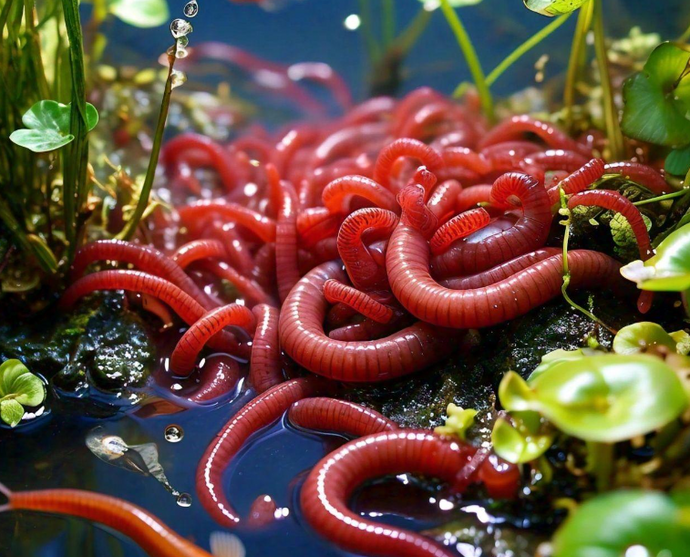Popular red worms: Tips for raising them
Wiki Article
Every Little Thing You Need to Learn About Red Wigglers for Composting
Red wigglers, or Eisenia fetida, play an essential duty in the world of composting, changing natural waste into beneficial dirt modifications. The process of establishing up a worm bin and maintaining it can pose difficulties.What Are Red Wigglers?

(Lake Rhodhiss Bait) Native to North America, red wigglers are surface-dwelling microorganisms that prefer moist, cozy environments abundant in disintegrating raw material. Their diet plan consists mainly of decaying plant material, food scraps, and various other organic debris, which they eat and break down efficiently. As they digest this product, they create nutrient-rich spreadings that boost dirt fertility.
Red wigglers are hermaphroditic, possessing both male and female reproductive body organs, and can recreate promptly under optimum conditions. On the whole, red wigglers are crucial contributors to the process of reusing natural waste into important garden compost.
Benefits of Making Use Of Red Wigglers
Making use of red wigglers in composting systems offers countless advantages that enhance both the effectiveness of waste administration and the quality of the resulting compost. These worms, scientifically called Eisenia fetida, are particularly efficient at breaking down organic matter, transforming cooking area scraps and yard waste right into nutrient-rich compost at an accelerated rate.One of the main benefits of utilizing red wigglers is their capability to consume large amounts of organic product, frequently refining their weight in food waste daily. This high consumption rate brings about quicker decay and decreases the volume of waste sent to garbage dumps. In addition, the castings created by red wigglers are abundant in vital nutrients, beneficial microorganisms, and enzymes, making them a superb plant food for gardens and plants.
In addition, red wigglers thrive in a selection of settings, making them adaptable for both interior and exterior composting systems - red wigglers. Their presence in a garden compost container aids to aerate the material, avoiding smells and promoting a healthy composting procedure. Generally, employing red wigglers not just contributes to effective waste monitoring but additionally sustains lasting gardening techniques through the manufacturing of top quality compost
(Lake Hickory Bait)
Establishing Up Your Worm Container
To efficiently establish up a worm container, it is important to select an ideal container that fulfills the demands of red wigglers while offering a helpful environment for composting. A suitable container can be made from plastic, timber, or steel, with a capability of a minimum of 1 square foot for every single extra pound of worms.Make certain the container has sufficient drainage holes to avoid excess wetness, as red wigglers grow in a wet, yet not water logged, setting. red wigglers. The container needs to likewise be ventilated to give adequate air movement, protecting against anaerobic conditions that can hurt the worms
A perfect place for the worm bin is a cool, dark area, free from straight sunshine and severe temperature levels, as red wigglers prefer a temperature level variety of 55 to 77 degrees Fahrenheit.
Prior to presenting the worms, prepare bed linen products such as shredded newspaper, cardboard, or coconut coir, which will certainly provide both habitat and food. Moisten the bed linens gently to develop a welcoming atmosphere for the worms. Consider positioning a lid on the bin to keep humidity and reduce insects, while ensuring it can be conveniently removed for maintenance.
Feeding and Care Standards
Feeding red wigglers is a crucial element of keeping a healthy and balanced composting system. These worms flourish on a diverse diet, largely composed of natural materials such as vegetables and fruit scraps, coffee grounds, and crushed eggshells. It is vital to avoid feeding them meat, milk, and oily foods, as these can produce unpleasant smells and draw in pests.When presenting food to your worm container, chop or shred products right into smaller sized items to assist in quicker decay. Start with percentages to evaluate the worms' consumption rate, slowly raising the quantity as they adapt. It is suggested to alternating feeding areas within the bin to motivate extensive blending and aeration of the garden compost.

Troubleshooting Common Issues
Preserving a prospering worm composting system can sometimes offer obstacles that call for attention and troubleshooting. Common issues include an unpleasant smell, which typically indicates overfeeding or the presence of anaerobic problems. To remedy this, lower the amount of food added and make certain proper aeration by blending the bedding material.Another constant trouble is the escape of worms from the container. This can happen due to extreme moisture or improper ecological conditions. On a regular basis inspect the moisture levels, going for a wet yet not soaked uniformity, and maintain optimal temperature levels in between 60-80 ° F(15-27 ° C )to produce a comfortable environment for your red wigglers.
Parasites, such as fruit flies, can also get into worm containers. red wigglers. To combat this, cover food scraps with a layer of bed linen or shredded paper to deter flies from laying eggs. Additionally, make certain that any type of food added is fresh and without mold, which can bring in unwanted parasites
Lastly, if your worms appear non-active, look for stress and anxiety factors such as temperature level variations or insufficient wetness. Attending to these usual issues will certainly assist keep a healthy and balanced and productive worm composting system.
Verdict
In summary, red wigglers, or Eisenia fetida, play a vital function in lasting waste management through vermicomposting. Their ability to successfully transform organic waste right into nutrient-dense spreadings enhances soil health and wellness and advertises plant growth. Proper setup and maintenance of a worm container, in addition to adherence to feeding standards, ensure a flourishing community that minimizes garbage dump contributions. Dealing with typical concerns immediately further sustains the effectiveness of this ecological method, contributing to environmental sustainability that site and farming performance.Report this wiki page